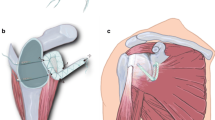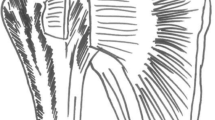Abstract
Introduction
The purpose of this study was to compare the outcome after arthroscopic antero-inferior shoulder stabilization with and without using a 5:30 o’clock portal.
Materials and methods
Sixty-two patients [age (mean ± SD), 28.05 ± 8.25 years] with a mean follow-up of 15.23 ± 5.02 months were included in this study. Thirty-one patients underwent arthroscopic antero-inferior shoulder stabilization using the 5:30 o’clock portal in center A (group I) and were compared to 31 matched patients managed with the 3 o’clock portal in center B (group II). Physical examination, standard shoulder scores, ultrasound assessment and subscapularis strength measurement were used to evaluate postoperative shoulder function.
Results
Good to excellent results were seen in both groups. No significant differences were seen when comparing ASES, Constant and Rowe Score of both groups. Patients of group II achieved a significant higher score in the SST than patients of group I. (p < 0.05) Patients of group I had a significantly lesser loss of passive external rotation in 0° and 90° of abduction. (p = 0.04; p = 0.056) Ultrasound evaluation and strength measurement showed no significant differences in subscapularis muscle integrity or function neither between the involved and uninvolved shoulder nor between both groups.
Conclusion
Arthroscopic anterior–inferior shoulder stabilization results in excellent clinical results. When considering portal placement, the deep trans-subscapularis portal allows a more precise suture anchor placement at the inferior glenoid rim and capsular shift with a significant improved external rotation but does not negatively affect the subscapularis function in terms of internal rotation strength or structural integrity.
Level of evidence
III.




Similar content being viewed by others
References
Hovelius L (1982) Incidence of shoulder dislocation in Sweden. Clin Orthop Relat Res 166:127–131
Vermeiren J, Handelberg F, Casteleyn PP, Opdecam P (1993) The rate of recurrence of traumatic anterior dislocation of the shoulder. A study of 154 cases and a review of the literature. Int Orthop 17(6):337–341
Arciero RA, Wheeler JH, Ryan JB, McBride JT (1994) Arthroscopic Bankart repair versus nonoperative treatment for acute, initial anterior shoulder dislocations. Am J Sports Med 22(5):589–594
Jakobsen BW, Johannsen HV, Suder P, Sojbjerg JO (2007) Primary repair versus conservative treatment of first-time traumatic anterior dislocation of the shoulder: a randomized study with 10-year follow-up. Arthroscopy 23(2):118–123. doi:10.1016/j.arthro.2006.11.004
Owens BD, Harrast JJ, Hurwitz SR, Thompson TL, Wolf JM (2011) Surgical trends in Bankart repair: an analysis of data from the American Board of Orthopaedic Surgery certification examination. Am J Sports Med 39(9):1865–1869. doi:10.1177/0363546511406869
Lenters TR, Franta AK, Wolf FM, Leopold SS, Matsen FA 3rd (2007) Arthroscopic compared with open repairs for recurrent anterior shoulder instability. A systematic review and meta-analysis of the literature. J Bone Joint Surg Am 89(2):244–254. doi:10.2106/JBJS.E.01139
Scheibel M, Nikulka C, Dick A, Schroeder RJ, Popp AG, Haas NP (2007) Structural integrity and clinical function of the subscapularis musculotendinous unit after arthroscopic and open shoulder stabilization. Am J Sports Med 35(7):1153–1161. doi:10.1177/0363546507299446
Cho HL, Lee CK, Hwang TH, Suh KT, Park JW (2010) Arthroscopic repair of combined Bankart and SLAP lesions: operative techniques and clinical results. Clin Orthop Surg 2(1):39–46. doi:10.4055/cios.2010.2.1.39
Mazzocca AD, Brown FM Jr, Carreira DS, Hayden J, Romeo AA (2005) Arthroscopic anterior shoulder stabilization of collision and contact athletes. Am J Sports Med 33(1):52–60
Marquardt B, Witt KA, Liem D, Steinbeck J, Potzl W (2006) Arthroscopic Bankart repair in traumatic anterior shoulder instability using a suture anchor technique. Arthroscopy 22(9):931–936. doi:10.1016/j.arthro.2006.04.105
Imhoff AB, Ansah P, Tischer T, Reiter C, Bartl C, Hench M, Spang JT, Vogt S (2010) Arthroscopic repair of anterior–inferior glenohumeral instability using a portal at the 5:30-o’clock position: analysis of the effects of age, fixation method, and concomitant shoulder injury on surgical outcomes. Am J Sports Med 38(9):1795–1803. doi:10.1177/0363546510370199
Bartl C, Schumann K, Paul J, Vogt S, Imhoff AB (2011) Arthroscopic capsulolabral revision repair for recurrent anterior shoulder instability. Am J Sports Med 39(3):511–518. doi:10.1177/0363546510388909
Tischer T, Vogt S, Imhoff AB (2007) Arthroscopic stabilization of the shoulder with suture anchors with special reference to the deep anterior–inferior portal (5.30 o’clock). Oper Orthop Traumatol 19(2):133–154. doi:10.1007/s00064-007-1199-1
Meyer M, Graveleau N, Hardy P, Landreau P (2007) Anatomic risks of shoulder arthroscopy portals: anatomic cadaveric study of 12 portals. Arthroscopy 23(5):529–536. doi:10.1016/j.arthro.2006.12.022
Lo IK, Lind CC, Burkhart SS (2004) Glenohumeral arthroscopy portals established using an outside-in technique: neurovascular anatomy at risk. Arthroscopy 20(6):596–602
De Simoni C, Burkart A, Imhoff AB (2000) Ein neuer inferiorer (5.30-Uhr-) Zugang für die arthroskopische Reparation des Bankart-Schadens. Arthroskopie 13(5):217–219
Rowe CR, Patel D, Southmayd WW (1978) The Bankart procedure: a long-term end-result study. J Bone Joint Surg Am 60(1):1–16
Constant CR, Murley AH (1987) A clinical method of functional assessment of the shoulder. Clin Orthop Relat Res 214:160–164
Lippitt SB, Harryman DT, Matsen FA (1993) A practical tool for evaluating function: the simple shoulder test. In: Matsen FA, Fu FH, Hawkins RJ, (eds) The shoulder: a balance of mobility and stability rosemont, Ill: American Academy of Orthopedic Surgeons, Rosemont, IL, pp 501–530
Richards RR, An KN, Bigliani LU, Friedman RJ, Gartsman GM, Gristina AG, Iannotti JP, Mow VC, Sidles JA, Zuckerman JD (1994) A standardized method for the assessment of shoulder function. J Shoulder Elbow Surg 3(6):347–352. doi:10.1016/S1058-2746(09)80019-0
Hedtmann A, Fett H (2002) Ultrasound diagnosis of the rotator cuff. Orthopade 31(3):236–246
Bartl C, Salzmann GM, Seppel G, Eichhorn S, Holzapfel K, Wortler K, Imhoff AB (2011) Subscapularis function and structural integrity after arthroscopic repair of isolated subscapularis tears. Am J Sports Med 39(6):1255–1262. doi:10.1177/0363546510396317
Pennock AT, Pennington WW, Torry MR, Decker MJ, Vaishnav SB, Provencher MT, Millett PJ, Hackett TR (2011) The influence of arm and shoulder position on the bear-hug, Belly-Press, and Lift-Off tests: an electromyographic study. Am J Sports Med 39(11):2338–2346. doi:10.1177/0363546510392710
Chao S, Thomas S, Yucha D, Kelly JD, Driban J, Swanik K (2008) An electromyographic assessment of the “bear hug”: an examination for the evaluation of the subscapularis muscle. Arthroscopy 24(11):1265–1270. doi:10.1016/j.arthro.2008.01.022
Tokish JM, Decker MJ, Ellis HB, Torry MR, Hawkins RJ (2003) The Belly-Press test for the physical examination of the subscapularis muscle: electromyographic validation and comparison to the lift-off test. J Shoulder Elbow Surg 12(5):427–430. doi:10.1016/S1058274603000478
Cohen J (1988) Statistical power analysis for the behavioral sciences, 2nd edn. L. Erlbaum Associates, Hillsdale
Greis PE, Dean M, Hawkins RJ (1996) Subscapularis tendon disruption after Bankart reconstruction for anterior instability. J Shoulder Elbow Surg 5(3):219–222
Maynou C, Cassagnaud X, Mestdagh H (2005) Function of subscapularis after surgical treatment for recurrent instability of the shoulder using a bone-block procedure. J Bone Joint Surg Br 87(8):1096–1101. doi:10.1302/0301-620X.87B8.14605
Gartsman GM, Roddey TS, Hammerman SM (2000) Arthroscopic treatment of anterior–inferior glenohumeral instability. Two to five-year follow-up. J Bone Joint Surg Am 82-A(7):991–1003
Owens BD, DeBerardino TM, Nelson BJ, Thurman J, Cameron KL, Taylor DC, Uhorchak JM, Arciero RA (2009) Long-term follow-up of acute arthroscopic Bankart repair for initial anterior shoulder dislocations in young athletes. Am J Sports Med 37(4):669–673. doi:10.1177/0363546508328416
Randelli P, Ragone V, Carminati S, Cabitza P (2012) Risk factors for recurrence after Bankart repair a systematic review. Knee Surg Sports Traumatol Arthrosc 20(11):2129–2138. doi:10.1007/s00167-012-2140-1
van der Linde JA, van Kampen DA, Terwee CB, Dijksman LM, Kleinjan G, Willems WJ (2011) Long-term results after arthroscopic shoulder stabilization using suture anchors: an 8- to 10-year follow-up. Am J Sports Med 39(11):2396–2403. doi:10.1177/0363546511415657
Frank RM, Mall NA, Gupta D, Shewman E, Wang VM, Romeo AA, Cole BJ, Bach BR Jr, Provencher MT, Verma NN (2014) Inferior suture anchor placement during arthroscopic bankart repair: influence of portal placement and curved drill guide. Am J Sports Med 42(5):1182–1189. doi:10.1177/0363546514523722
Dwyer T, Petrera M, White LM, Chechik O, Wasserstein D, Chahal J, Veillette C, Ogilvie-Harris DJ, Theodoropoulos JS (2015) Trans-subscapularis portal versus low-anterior portal for low anchor placement on the inferior glenoid fossa: a cadaveric shoulder study with computed tomographic analysis. Arthroscopy 31(2):209–214. doi:10.1016/j.arthro.2014.08.009
Buchmann S, Brucker PU, Beitzel K, Bock J, Eiber M, Wortler K, Imhoff AB (2016) Long-term effects on subscapularis integrity and function following arthroscopic shoulder stabilization with a low anteroinferior (5:30 o’clock) portal. Knee Surg Sports Traumatol Arthrosc 24(2):422–429. doi:10.1007/s00167-015-3545-4
Author information
Authors and Affiliations
Corresponding author
Additional information
IRB Number 354/15 (Ethics Committee of the faculty of medicine of the Technische Universitaet Muenchen).
P. Minzlaff and J. Ackermann contributed equally for first authorship.
Rights and permissions
About this article
Cite this article
Minzlaff, P., Ackermann, J., Seppel, G. et al. A multicenter study to evaluate subscapularis muscle function using 5:30 o’clock portal for antero-inferior shoulder stabilization. Arch Orthop Trauma Surg 136, 1143–1152 (2016). https://doi.org/10.1007/s00402-016-2467-z
Received:
Published:
Issue Date:
DOI: https://doi.org/10.1007/s00402-016-2467-z




